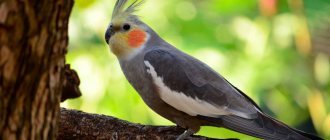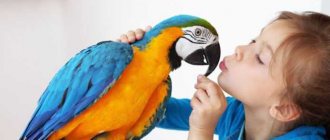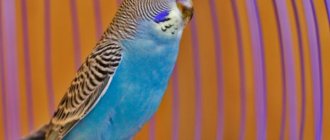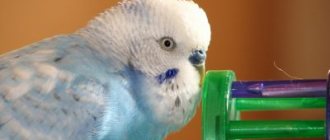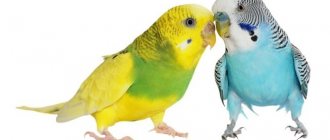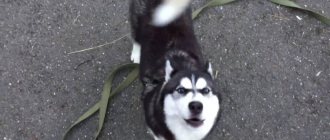Features and character of a parrot
If you have a Corella, be prepared to give him a lot of attention.
Corella is a bird with character. The parrot does not tolerate neglect of its own person and requires increased attention. The bird takes root in the house and begins to show abilities only after it feels like a member of the family.
A feature of the Corella parrot's character is its attachment to its owner. The bird establishes close contact with only one family member, most often a woman. The bird completely gets used to home conditions and all the inhabitants of the house in the second year of life.
The process of raising a parrot must begin with taming. Young individuals are the easiest to tame. The older the bird, the more difficult it will be to establish contact with it and teach onomatopoeia skills.
Contact with the bird is fundamental. The bird will not repeat words after a person who is unpleasant to it. Once your friendship with Corella has been established, you can begin training.
Only a lonely bird can learn to speak. If several parrots live in a house, they will communicate with each other in their own language. In this case, the parrot will not repeat the words after the owner.
Keeping at home
Teaching your cockatiel to repeat words is much easier when he is alone with you. It is necessary to exclude any extraneous sounds, flashes of light, noise, foreign odors - remove bright and moving objects, mirrors, other animals, children from the room. The bird is very inquisitive and will be constantly distracted by any, even insignificant, stimuli.
In the case when several cockatiels live in one cage, then during the training the parrots are seated in different rooms so that the bird’s attention is concentrated on you and the words you say. Parrots living in pairs can also learn. Since it is more difficult to train a female, it is usually the male that is trained. During the lesson, the male is also transferred to a room separate from the female.
In order for your pet to want to learn to talk, it must have proper care, optimal levels of vitamins and minerals in its diet, and be free from disease and shedding. An active, healthy and curious bird should not be afraid of contact with you and willingly allow itself to be picked up. If you see that your parrot is flapping its wings and making clicks with its beak, this is a sure sign that it is now in a good mood and now is the best time to study.
When repeatedly saying phrases or individual words to your parrot to memorize, pay attention to how the bird behaves.
Some cockatiel owners try a test session to see if their parrot is capable of learning and remembering words. To do this, throughout the day, a simple and short word is repeated to the bird with the same intonation at least 50 times (the more, the better).
READ Why adult cats shouldn't drink milk
It is believed that you need to start studying by voicing the parrot’s name, for example, telling it: “Kesha” or “Kesha is good.” If during the learning process the cockatiel shows signs of interest and tries to repeat out loud what it has learned by the end of the lesson, then there is a point to further study. However, it is still not worth judging learning abilities based on one day. The natural intellectual capabilities of each parrot may be different, and one that does not speak in 1 day can give excellent results after several full sessions.
Repeating the same phrase several dozen times every day is a rather tedious task for any person. If you do not have the time and opportunity to conduct regular voice lessons with your parrot yourself, then a smartphone or computer can come to your aid. To do this, you need to record a voice file and play it repeatedly. The bird is left in a room where it listens to an audio recording many times throughout the day. In this way, the parrot remembers the new word or phrase and can reproduce the lesson it has learned.
In addition to words, a parrot can learn to whistle. The cockatiel imitates the whistle best, but it does not reproduce speech quite clearly. A parrot can be taught to imitate a musical melody by whistling it in the presence of the bird quite often so that it can remember and reproduce what it hears so often.
A talking cockatiel parrot is always the pride of the owner, because behind every word learned there is a lot of painstaking work, into which time and patience are invested. Those breeders who teach their parrots to imitate speech believe that lessons with the bird are a pleasant pastime during which they communicate and play with their beloved pet.
For some secrets to teaching your cockatiel to speak, watch the video below.
The bird is unpretentious, but there are certain subtleties in its maintenance that you must be aware of at the stage of planning your purchase. First you need to learn how to feed and care for the nymph, and only then go after the chick. The health and life of your pet depends on the quality of care. Good care and maintenance allow cockatiels to live at home for more than 10 years, to be vigorous, beautiful, and active.
Feeding
By nature, the nymph parrot is granivorous. The ideal food for him would be a mixture of cereals. The nymph will not refuse fruit either. He enjoys eating pieces of apples, oranges and bananas. In spring, it is useful to provide twig food, from which the bird will peck buds and bark.
Poor quality food leads to gastrointestinal disorders, so food should always be fresh. Feed is given twice a day so that it is eaten within 10-15 minutes. It is allowed to add grain in the evening, before closing the cage, then the parrot will be able to have breakfast early. After feeding, all residues are removed, the feeder is rinsed and wiped dry.
Composition of the grain mixture:
- canary grass seeds,
- millet,
- oats,
- hemp.
You can include some rapeseed and rapeseed seeds in the mixture. Birds eat dried wheat reluctantly. It needs to be soaked or germinated. Hemp seed can be given no more than a dozen grains per day, otherwise the bird may go blind.
Occasionally poppy seeds are introduced into the diet. They prevent digestive disorders. Poppy seeds can be added to carrot pulp or given separately.
An adult pet eats 2 tablespoons of grains per day.
There should always be clean water in the cage. Drinkers are washed once a day. Occasionally, you can give mineral water instead of regular water.
Mineral supplements required:
- sepia,
- crushed boiled shells,
- sand.
Once a week, add 2 drops of fish oil to the grain. Twice a month give 1-2 tablespoons of sprouted grain. The size of the sprouts should be no more than 1 mm. Give a multivitamin preparation twice a week in the amount indicated on the package.
Care can be daily or weekly. It is enough to do something once a month or a year.
Daily:
- wash the drinking bowl and feeder;
- change water and food;
- clean the bottom, bath and sandbox;
- wash and wipe dry perches and perches;
- scald with hot water, dry and hang the toys again.
Once a month:
- change branches;
- carry out disinfection with a bleach solution.
Change once a year:
- feeders,
- drinking bowls,
- perches,
- bath,
- toys.
The pet must be allowed into the room. Without this, he will not be able to maintain good shape. Each nymph parrot must fly about 1 km daily - its life expectancy depends on this.
In the warm season, the cage is taken out into the fresh air so that the pet receives ultraviolet light. At the same time, there must be shaded areas in the house where the nymph can hide from overheating.
In winter, daylight hours are extended by turning on fluorescent light bulbs for 4-5 hours. The optimal temperature for keeping is 18…20 C. Birds tolerate cold better than overheating.
Attention
You need to communicate with your pet daily. In nature, birds live in numerous flocks. Communication is vital for them.
The bird is given a lot of time from the first days of its appearance in the house. It will not be difficult to communicate with her - parrots love to play and learn new things. In nature, they constantly maintain contact between all members of the pack and exchange various signals.
By taking a young chick into your home, you can accustom it to yourself in just two weeks. The first days together will be a great time to establish an atmosphere of trust and friendship for the rest of your life. A tamed pet becomes a member of the family, easily learns to talk and perform simple tricks.
Hand training begins when the nymphal parakeet fearlessly takes food from the feeder. You need to stick your palm with grains into the cage and wait until the bird starts pecking at them.
Then it’s time for walks. Holding the bird in your hand, it is easy to take it out of the cage, and after a while, lure it back into your palm and return it to the house. Such exercises are repeated daily during feeding. Typically, walks begin no earlier than one to two months after purchase.
While traveling around the room, the parrot faces many dangers. You need to make sure that the windows are closed so that your feathered friend does not get his claws tangled in the curtains or become a victim of a cat or dog. All risks must be foreseen and the room where the nymph will fly must be prepared in advance.
Cleanliness is the key to health, so the cage needs to be cleaned daily and disinfected once a month. The bottom is covered with washed dry sand. You cannot put paper on the bottom - birds love to eat it, which is harmful to their health.
To play in the cage, a ladder and a swing are suspended. If the pet does not have a mate and the owner often leaves home, additional toys will be needed: a mirror, bells, balls strung on wire.
READ How often can you give Milbemax to cats?
When to start studying
When your pet is 35–40 days old, you can begin training
It is advisable to determine the ability to reproduce human speech when choosing a chick during purchase. The gifted chick doesn’t just squeak, it changes the tone of its voice and makes various other sounds.
Interesting: Make a parrot cage yourself!
Chicks begin to learn speech at the age of 35–40 days. At this time, the bird is most receptive to everything new, so the process of memorizing words occurs quickly. The parrot pronounces its first words 2–2.5 months after the start of classes.
How to determine gender
The female differs from the male in the shade of her plumage. The spots on her head are not red, but brownish; the crest is not straw, but dirty yellow. Females have spots on the inside of their flight feathers. The tail feathers are paler than those of males and covered with black stripes.
How to determine age? The older the bird, the lighter its eyes. Young specimens have black pupils, while older specimens have gray pupils. The paws, beak and wax, on the contrary, darken with age. In young birds, the mandible, beak and claws are smooth with a gray tint, and there are almost no scales on the fingers. With age, the integument becomes coarser, the paws and claws become covered with scales.
The crest of chicks consists of straight feathers, while that of adults consists of curved feathers. The first change of feathers occurs at 6-8 months. After it, the plumage acquires the rich color typical of cockatiels. A bird purchased at a young age must moult from its new owner. If this does not happen, the cockatiel was more than 8 months old at the time of purchase.
The Corella parrot is a fun pet that can learn to talk and be trained. He needs standard care for parrots. Keeping this bird is accessible to everyone, regardless of knowledge of ornithology.
How many words can Corella say?
It may seem like Corella is engaging in meaningful dialogue with you, but that's not the case.
The record speech performance of Corella parrots is 30–35 words and a few simple sentences. The bird pronounces words not consciously, entering into dialogue with a person, but mechanically . But at the same time, they can be associated with certain actions, so it seems that the bird understands the meaning of the phrases.
A parrot can be taught to sing. The bird easily reproduces melodies and is able to repeat several lines from a frequently repeated song. Basically, the parrot remembers a frequently repeated chorus or a separate phrase from a song.
It will not be possible to control the process of repetition of a song by a parrot, so you need to try to make it remember an unobtrusive melody. Otherwise, the performed motive will subsequently begin to irritate the owner and other family members.
What to consider before training
All owners want their beloved bird not only to coo peacefully and chirp joyfully, but also to be able to utter some words. However, beginners immediately have a problem - complete ignorance of how to teach a parrot to speak, as well as the main features of special lessons.
A talking cockatiel is not uncommon among parrots of this breed. But in order for him to be able to pronounce words, he needs help in this matter. This bird has abilities, great intelligence, and amazing memory capabilities. This means that speech training will be carried out quickly.
Optimal age
When teaching parrots words, it is important to take into account their age; this requirement is of great importance. Preference should be given to young individuals, they are easier to train. If a cockatiel parrot speaks, then it is probably no more than 2-3 months old; they quickly remember speech.
We recommend reading: Cage for a cockatiel parrot: dimensions, manufacturing and arrangement
When selecting a bird depending on its age, it is worth considering some features:
- for learning to speak, it is worth purchasing a bird at the age of 2-3 months;
- Before buying, you need to listen well to the nature of the squeaking of the chicks. A capable and gifted parrot, in addition to squeaking, will make other sounds and change their tonality;
- If you decide to teach an adult bird to talk, it will be difficult. She won't even be able to remember phrases.
Why can't adult cockatiels learn human speech? They have long-established habits and morals, and many do not want to perceive and remember new ones. Therefore, you can’t expect results from them.
Sometimes you can hear your cockatiel already talking. Perhaps the sellers have already taught him how to speak. In this case, you should be prepared for the fact that the bird will cost several times more.
Female or male
Males are believed to be capable students. For this reason, it is worth choosing males for training. Unlike females, they can remember and pronounce 2-3 dozen words and easily remember the simplest phrases.
This is interesting! Do cockatiels talk to humans? Unfortunately, no, they don't understand what people are asking them. They just mechanically repeat memorized phrases.
Is it possible to teach a female cockatiel to talk? They are trainable, but their vocabulary will be small. Not everyone will have the patience or strength to teach a bird some words. But there are situations when females turn out to be much smarter and more agile.
How many words can cockatiels say?
A cockatiel parrot can pronounce a maximum of 30-35 words and a couple of simple sentences. The bird pronounces them unconsciously, on a mechanical level. But sometimes they can be associated with actions, for this reason there may be a feeling that she knows their meaning.
Talking cockatiels can learn to sing. The bird reproduces melodies with ease and can speak several lines of repeated songs.
Features of learning depending on gender
Males are more trainable than females
Learning ability mainly depends on the individual abilities of the birds, but gender has a certain influence. Males are more capable and learn words faster. The training of birds of different sexes has some differences.
How to teach a female Corella to talk
Some owners of Corella parrots have the opinion that females cannot be taught to pronounce words. In fact, this process is longer than when training males. Having learned to speak, females pronounce words louder and more clearly. Although girls have a much smaller supply.
For assimilation, words with the sounds “a”, “o”, “p”, “t”, “r” are selected. It is better to associate words with certain actions. Saying “Hello!” while entering the room and “Bye!” while leaving.
The bird can learn words that are often, loudly and emotionally spoken by the owner, so you should be careful when using curses and obscenities. Otherwise, Corella will say them at the most inopportune moment - for example, in front of strangers.
How to train a male
Active communication with a parrot is a necessary condition for successfully teaching its speech. For classes, choose a time when the parrot is in a good mood - preferably in the morning or evening. You can teach a male Corella to talk by following these recommendations:
- Classes should last 15–20 minutes 2 times a day;
- The first words should be short. It is recommended to start learning with the name of the bird;
- When the bird is active, whistles and demonstrates a desire to communicate, learning words begins;
- The bird best remembers words associated with actions: feeding, waking up, hygiene procedures;
- The question “How are you?” addressed to the bird at every meeting4
- Classes are conducted in silence, without the presence of other family members. The parrot should not be distracted by anything, so it is better to remove toys and other bright objects during training;
- The bird must be praised for every sound it makes. A treat after each spoken word will help to consolidate success;
- If the parrot refuses to communicate, you cannot insist. Exercises under coercion will not produce results;
- The parrot will only repeat phrases that it hears daily, so they need to be said constantly;
- The phrases that the parrot must remember must be selected in advance. During the course of learning, you cannot abandon one unlearned word and start learning another;
- Only one person should handle the bird. The bird will not perceive voices of different timbres. It is advisable that the Corella parrot be taught to speak by a woman;
- Sounds are pronounced clearly, in a firm voice. But you can’t scream at the same time, the bird will be nervous;
- They begin to learn a new phrase only after the bird has mastered the previous one. Too much information at the same time is too difficult to digest;
- You need to be patient while practicing. You should not be angry that the bird learns words too slowly, otherwise the result will be negative due to the loss of contact with the pet;
- Each word is pronounced with constant intonation. The parrot remembers not only the word itself, but also the tone in which it is pronounced. A change in intonation will confuse the bird, and it will learn the word very slowly.
You cannot conduct classes with a sick or tired bird. Negative emotions during exercise will disrupt the contact between the owner and the pet.
Can cockatiels talk?
These birds have a good memory, they are able to learn many words and some phrases.
The main thing is to establish a trusting relationship between you. A parrot doesn't talk if it doesn't trust you. It will be impossible to train such a pet to imitate words and phrases. It is worth knowing that not all species of parrots are capable of reproducing human speech. If you want to have a talking bird at home, it will be useful to know which parrots can be taught to speak. And, of course, even the most capable birds will not learn to talk in 5 minutes or even in 1 day.
For a bird to acquire such a skill, the owner will need to be patient and put in a lot of effort. The most well adapted to living conditions in captivity, and also having pronounced abilities to reproduce speech:
- budgerigars;
- cockatiel;
- Amazons;
- cockatoo;
- gray;
- macaw;
- rosella;
- lovebirds.
Small budgies are distinguished by their high “speaking” abilities. They begin to imitate human speech earlier than others. With the right approach to training, these creatures can master several hundred words.
Many pet stores often sell budgerigars that already speak. Of course, they are more expensive, but you will no longer need to train your pet, all you have to do is enjoy communicating with him. But the pronunciation of these birds is not very clear, so it is not always possible to determine what the pet is saying.
It is better to train male cockatiels, they are more capable than females, they can remember and reproduce 20-30 words, as well as several simple phrases. The older the bird, the more difficult it is to teach it to speak. When paired, these birds learn very poorly. Therefore, if you want to quickly teach a cockatiel parrot to speak, work with a two- to three-month-old single male.
Grays are among the smartest species of parrots. This bird with gray plumage attracts breeders not because of its colors, but because of its intellectual abilities. Listening to a parrot talk can feel like you are having a meaningful conversation with the other person.
These feathered ways to include over 500 words in your vocabulary. They can be taught to speak complex phrases, poems and even sing songs. Thanks to an inquisitive mind and increased curiosity, it is not difficult to quickly teach a gray parrot to speak. But these birds are not recommended for beginners to keep at home due to the difficulties of raising them.
Among the large species of birds that have a high ability to imitate speech, cockatoos stand out. These are large birds with an unusual appearance; they are able to learn not only words, but also phrases. However, they are not taught quickly. Teaching a cockatoo to speak requires long, painstaking work.
In the wild, of course, not a single parrot speaks, but in captivity, having heard the sounds of human speech, the cockatiel can begin to repeat them. Among its gray-colored hybrid relatives, the red-cheeked one lends itself best to conversational speech. The nymph can imitate not only conversation, but also other sounds: whistling, dog barking, the melody of a telephone call, the sound of a working vacuum cleaner, the sounds of other birds.
Experienced breeders of Corella parrots can even have their pets sing, thereby expressing their joyful emotions. But in order to achieve this, a certain training was still carried out with the parrot, without which he himself would hardly have started singing.
An essential point when choosing an individual for training is its friendly nature. If your pet is open to communication, willingly goes into your arms, and looks at you with interest, your chances of good results are high. If the parrot does not want to contact anyone, behaves warily, fearfully, when trying to pick it up, it regards it as aggression towards itself and begins to fiercely defend itself, then you are unlikely to be able to teach it to talk.
A parrot can remember simple phrases, usually they are like this:
- "Hello";
- "go to sleep";
- “I will swim”;
- "let's play";
- "good";
- “give me a drink”;
- "I want to go out";
- “it’s time for you”;
- "Bye";
- "I will eat";
- "How are you".
These and any other phrases can be combined with the name of the parrot and studied at the moment when the action denoted by this word is carried out. For example, the phrase “I will bathe” should be said to the parrot at the moment when it is bathing in a tray of water. The word “hello” should be said when you see your bird in the morning or simply enter the room. Word and action create a strong associative connection that improves memorization processes.
A talking parrot is, as a rule, the merit of its owner. Corella can remember up to 35-40 words. The bird, of course, does not understand the semantic essence of the memorized words and repeats them mechanically, thoughtlessly. When, during the learning process, a word was combined with an action or the appearance of an object, and an associative connection was established, the parrot can reproduce the words supposedly “deliberately,” although in fact this is not the case.
How to teach a cockatiel to speak in 1 day
Modern technology will help speed up the learning process
Interesting: Food for tits - what to put in the feeder?
To expressly teach a parrot a few words, you need to use technology: a computer or smartphone. The parrot will need to be left alone with the speaker running all day. Using a microphone, you need to record words that the bird will hear periodically throughout the day.
Files are played every hour or half hour. You can program this playback mode on your computer using the xStarter program, which will launch the player at the set time and with the required frequency. A capable bird will begin to pronounce 1-2 words by the end of the day.
But teaching speech cannot be completely trusted to technology. If the parrot hears only recorded speech, the bird will only speak words when alone.
When leaving the bird alone with the computer, you need to install the equipment so that the inquisitive pet does not harm it.
